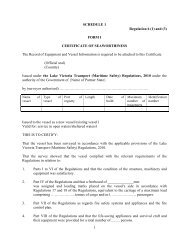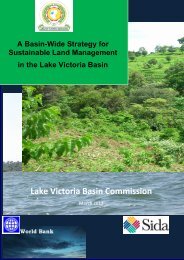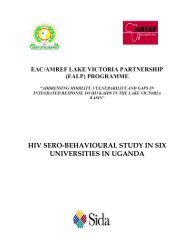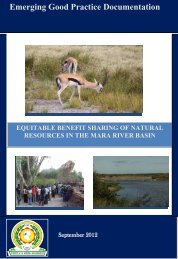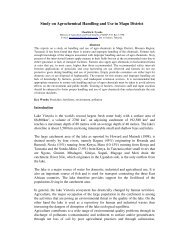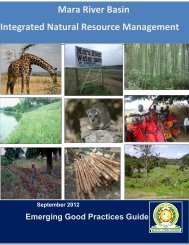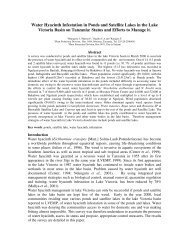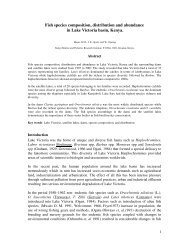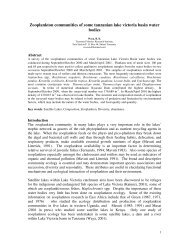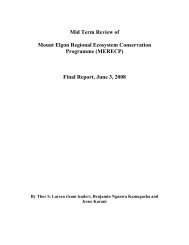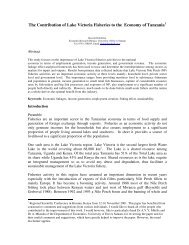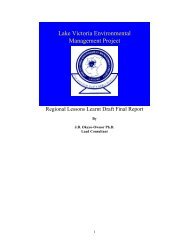Total Economic Value of Maasai Mau, Trans Mara and Eastern Mau ...
Total Economic Value of Maasai Mau, Trans Mara and Eastern Mau ...
Total Economic Value of Maasai Mau, Trans Mara and Eastern Mau ...
You also want an ePaper? Increase the reach of your titles
YUMPU automatically turns print PDFs into web optimized ePapers that Google loves.
The role <strong>of</strong> the <strong>Mara</strong> Basin in tourism <strong>and</strong> wildlife support was estimated using thewillingness to pay by tourists estimated using the travel cost method as the expenditure<strong>of</strong> touring the game reserves that are supported by the forest blocks. The SerengetiNational Park receives up to 130,000 tourists a year paying US$ 6 million in gatecharges (TSB, 2000). With about 20% <strong>of</strong> these guests staying in the park for one or morenights <strong>and</strong> each spending each US$ 200, 3 an additional US$ 5,200,000 accrues tohoteliers <strong>and</strong> other facilitators including the cottage industries.The Kenyan part <strong>of</strong> the <strong>Mara</strong> Basin houses the <strong>Mara</strong> National Reserve with about 80hotels, mostly used by tourists (see Appendix 7). The total bed capacity <strong>of</strong> the hotels is3,466 with an occupancy rate <strong>of</strong> about 56% (if we assume the hotel bed occupancy <strong>of</strong>about 56%, the same as that reported for Serengeti; see Appendix 7; URT, 2001). Thus,on average, 1,941 visitors spend the one or more nights in the <strong>Mara</strong> National Reservespending about US$ 200 per day. The cumulated earnings at the <strong>Mara</strong> spent by 708,450tourists who spend the night in the Kenyan hotels are US$ 141 million. Another KES 650million (US$ 8,666,667) is collected as gate charges to the reserve.The total value <strong>of</strong> the forest blocks did not include extra benefits that accrue from the<strong>Eastern</strong> part <strong>of</strong> the forest in influencing tourism activities at the Lake Nakuru <strong>and</strong> LakeNaivasha national parks.3.6 <strong>Value</strong>s <strong>of</strong> Forest BiodiversityUsing the benefit transfer method, the option value for the rich flora <strong>and</strong> fauna wasestimated using the benefit transfer method. Using the value <strong>of</strong> US$ 10/ha by assuminga medium biodiversity compared with the South American forests, the forest blocks arevalued at KES 109.8 million (US$ 1,464,000).3.7 Valuation <strong>of</strong> Forest for Carbon SequestrationThe three forest blocks provide two dimensions in carbon storage: (i) the amount <strong>of</strong>carbon stored in the st<strong>and</strong>ing forest (carbon balance); <strong>and</strong> (ii) the carbon sequestered ina growing forest. The carbon stored in the st<strong>and</strong>ing forests would be lost if the trees arelogged. Carbon markets have existed since 1989 <strong>and</strong> refer to the sums <strong>of</strong> money that3 According to Tanzania tourism ministry, the average daily expenditure per tourist has been increasing over time.For example, in 1991 the average expenditure per day was US$ 72.42 which increased to US$ 152.00 in 1999.Based on this trend <strong>and</strong> from information obtained through interaction with key informers, we assumed thattourists spend US$ 200 per day at the Serengeti or the <strong>Maasai</strong> <strong>Mara</strong>.37



